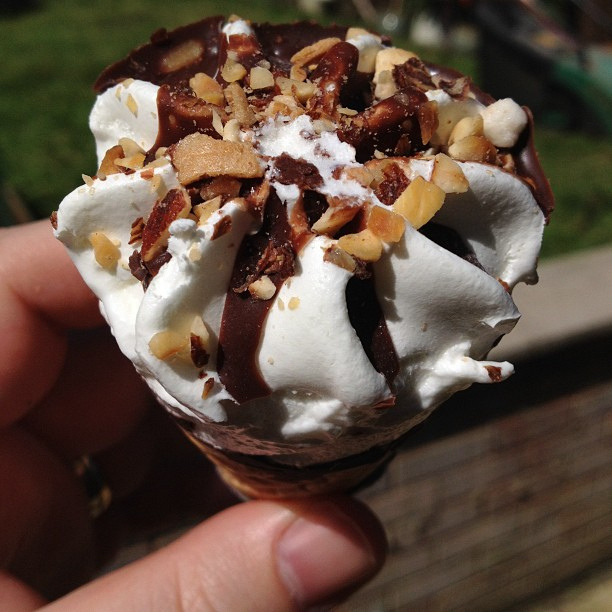Listening is a natural way to learn a language. We offer a very easy way to learn Italian: Just Listen. With “Listen to Italian” you can easily improve your listening comprehension. Listen as much as you can and then do the activities you’ll find at the end of the page. Enjoy today’s activity with Listen & Learn Italian “Il gelato italiano.”
Il Gelato Italiano
🎧 AUDIO
Transcription
Gli italiani amano mangiarlo a tutte le età e in tutte le stagioni, anche se fuori fa freddo.
Parliamo del gelato: alla frutta, al cioccolato, al caffè, con la panna, nella crêpe, nella brioche, in spiaggia, al bar, in casa, sempre e dovunque viene consumato anche da chi non ama molto i dolci.
L’antenato del gelato attuale è sicuramente rappresentato da frutta, latte e miele ghiacciati o, con l’avvento degli arabi in Italia, dalla prima forma di granita creata grazie alla canna da zucchero della Sicilia.
Sembra, invece, che la prima versione del gelato simile a quella attuale si debba ad un cuoco siciliano, Francesco Procopio dei Coltelli, famoso in Francia come “Le Procope”.
Francesco prova ad usare lo zucchero al posto del miele e a mischiare il sale al ghiaccio per mantenere la consistenza più a lungo.
Questa geniale intuizione lo porta al successo che gli permette di aprire il “Café Procope” a Parigi, meta di personaggi famosi del tempo.
Altri storici attribuiscono la nascita del gelato moderno a Bernardo Buontalenti, architetto fiorentino, che ha l’idea di usare come ingredienti il latte, la panna e le uova.
Come spesso accade, non abbiamo notizie certe riguardo alla nascita di questo alimento, ma sicuramente l’Italia è nota come la patria del gelato e all’estero la denominazione “vero gelato italiano” è sinonimo di “alta qualità”.
Il gelato italiano più ricercato è quello artigianale per cui si affollano le gelaterie che accontentano tutti i palati.
Oltre a quelli classici, infatti, troviamo gusti sempre più strani e legati ad alimenti caratteristici delle varie regioni, come “spinaci”, “peperoncino”, “pesto” e molti altri.
Gli italiani, però, amano molto anche il gelato industriale come il cornetto Algida, il famoso “cuore di panna”, semplice ma buonissimo, apprezzato da ogni generazione.
VOCABULARY
- età (ages)
- stagioni (seasons)
- fuori (outside)
- fa freddo (it is cold)
- panna (cream)
- spiaggia (beach)
- casa (home)
- dovunque (everywhere)
- antenato: (ancestor)
- latte (milk)
- miele (honey)
- ghiacciati (frozen)
- granita (ice)
- canna da zucchero (sugar cane)
- cuoco (cook)
- sale (salt)
- uova (uovo)(eggs)
- patria (home country)
- artigianale (handmade)
- palati (palates)
- cornetto (ice cream cone)
- cuore (heart)
IL CORNETTO ALGIDA

Gli italiani e il Gelato
Nocciola hazelnut Limone lemon Fragola strawberry Stracciatella vanilla-flavoured ice cream with chocolate chips Pistacchio pistachio Gustare taste Lentamente slowly Goloso greedy Cremoso creamy Nutriente nutritious
🎧 AUDIO
TRANSCRIPTION
Secondo la ricerca dell‘Istituto del Gelato Italiano, il gelato piace al 95% degli italiani.
In fatto di gusti, gli italiani sono amanti della tradizione e quelli più amati sono sette:
al primo posto c’è il cioccolato,
al secondo la nocciola,
seguono in ordine:
- il limone,
- la fragola,
- la crema,
- la stracciatella,
- il pistacchio.
La maggior parte degli italiani, l’80%, preferisce gustare il gelato lentamente, impiegando in media sette minuti per mangiare un cono.
Inoltre una cosa è certa: i fan del gelato a casa sono più numerosi di quelli del gelato consumato fuori casa.
L’estate si conferma la stagione ideale per il gelato: il 94% degli italiani dichiara di consumarlo soprattutto in questa stagione.
Il pomeriggio e il dopo cena sono i momenti migliori per mangiare un gelato.
Insomma, il gelato piace.
Piace perché è buono, goloso, freddo, cremoso e nutriente.
E fa ricordare il mare, le vacanze, le passeggiate e le serate con gli amici.
Un gelato di 120 kg per tre metri di altezza
Vocabulary
Progetto project Pasticcere pastry chef Burro butter Suocero father-in-law Cannella cinnamon Cottura cooking Lampone raspberry
🎧 AUDIO
TRANSCRIPTION
Centoventi chili di gelato, un cono gigante, 48 ore di lavoro, un progetto durato molti giorni, il tutto per fare il gelato più grande del mondo.
Antonio Cafiero, un famoso pasticciere di Sorrento (Napoli), ha lavorato con altri dieci pasticcieri e il suocero, Mario Maresca.
Tutti insieme per creare una bontà da guinnes dei primati.
Primo passo: il cono.
Gli ingredienti sono quelli tradizionali: farina, zucchero, burro, uovo, cannella, vaniglia e cacao in polvere, il tutto in grandi quantità.
Secondo passo: la cottura, tre ore e trenta minuti.
E in ultimo, il gelato: ben 120 kg di palline di vari gusti: crema, pistacchio, nocciole, caffè, fragole, lampone.
Il gelato “tutto italiano”, come ha precisato Antonio Cafiero, ha raggiunto l’altezza di 2 metri e 76 centimetri.
What’s next?
You might want to keep learning Italian online with these free resources:











Leave a Reply